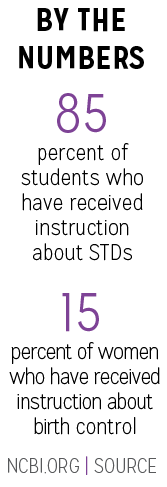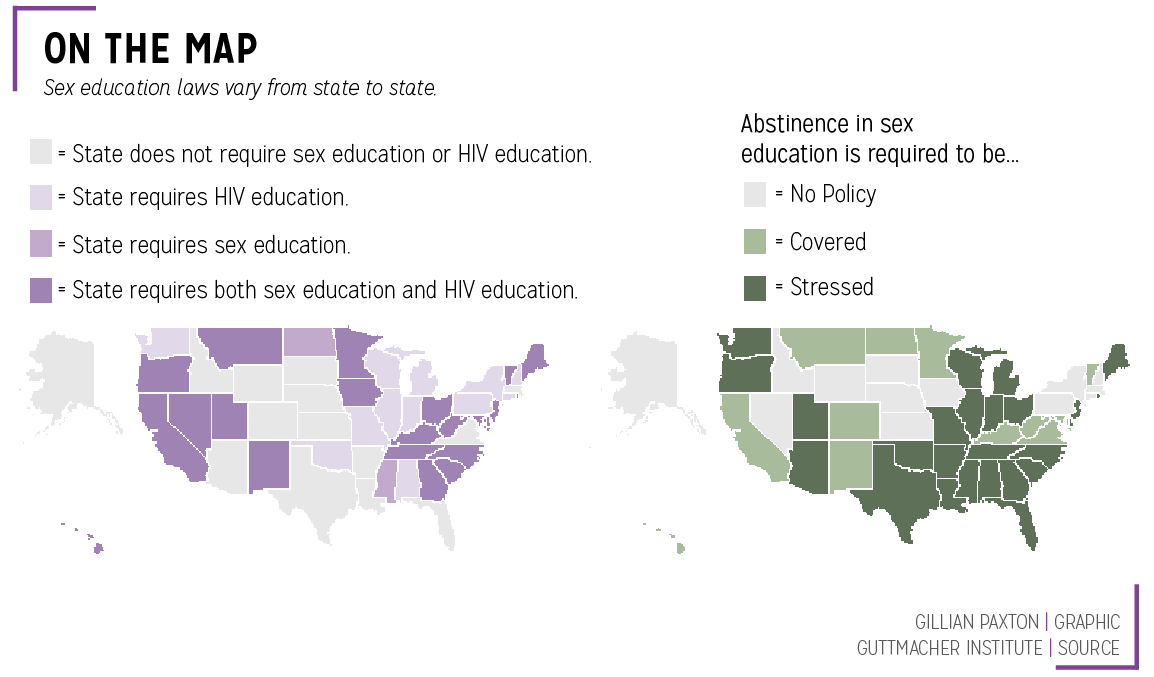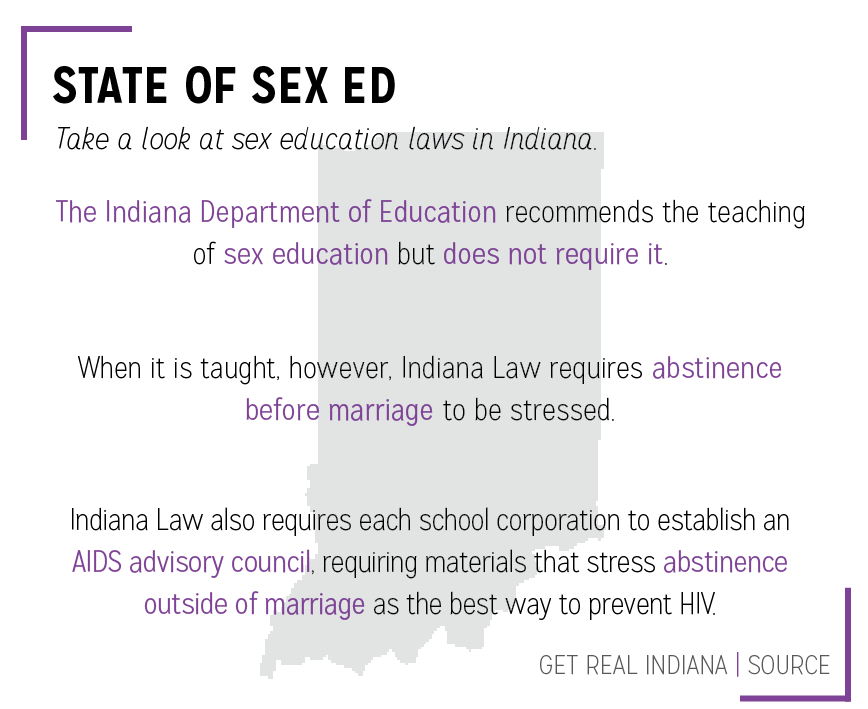Learning the Hard Way: Teen pregnancy, STI rates significantly higher in conservative states due to inadequate sex education

 Indiana law requires teachers to teach abstinence in sex education, but prohibits teaching students about the risks and preventative measures associated with sex. However, mountains of evidence show students would be safer, healthier and no more likely to engage in sex if comprehensive sex education was taught.
Indiana law requires teachers to teach abstinence in sex education, but prohibits teaching students about the risks and preventative measures associated with sex. However, mountains of evidence show students would be safer, healthier and no more likely to engage in sex if comprehensive sex education was taught.
According to a 10-year government study, abstinence-only programs do not delay sexual activity in teens or lower rates of pregnancy or sexually transmitted infections. While almost all other developed nations teach safe sex, the United States focuses heavily on preaching abstinence. This is arguably the reason the United States has the highest teen pregnancy rate among developed countries. However, states such as Washington, Massachusetts and New York adopted a comprehensive sex education and have measured a massive decrease in teen pregnancy, according to the U.S. Department of Health and Human Services.
The main argument from people who advocate abstinence is it will prevent teenagers from having sex, thus protecting them from pregnancy and STI’s. Unfortunately, it does neither of those things. The Centers for Disease Control and Prevention (CDC) states it is imperative teens have access to evidence-based prevention programs.
However, that’s not to say all teenagers should be taught to have sex in their teenage years. In fact, the CDC also suggests teens have access to programs that educate on and support healthy choices in relationships as well as with birth control. The U.S. Department of Health and Human Services (HHS) even has programs designed for specific communities based on the majority race and religion. For example, teen pregnancy rates are significantly higher among minorities, so one program focuses on educating minorities on how this can hold their community back as well as how to work toward fixing it. For more religious or traditional communities, there are programs that teach the benefits of abstinence and waiting to have sex, but still provide information on how to protect oneself and others should they choose to have sex.
These programs provide a holistic and safe approach to sex education. In fact, both sides of this polarized issue should feel safe in knowing teenagers are learning how to protect themselves without being encouraged to have sex, but also learning how to be emotionally mature in approaching this aspect of their lives.
Again, in this sense, it’s not about banning abstinence or even teaching teenagers they should have sex at their current age; it’s about educating them on how to protect themselves and others from potentially life-changing outcomes such as pregnancy, STI’s or even emotional damage.
Just as people who advocate for abstinence and celibacy do not want to be told they should have sex, young adults who make a mature and informed decision should not be taught they can’t have sex until they are married because the Indiana state law says so. In fact, since the 1990s, teen sexual activity has decreased almost 10 percent, according to the Resource Center for Adolescent Pregnancy Prevention.
In addition, the motives for abstinence-only sex education are often skewed. Despite the Establishment Clause’s function to separate church and state, abstinence-only sex education enforces religious ideology rather than medical facts about sex. Religious ideology states sex is sacred and between a married couple for the sake of reproducing. However, psychologist Noam Shpancer, Ph.D. et. al have found that couples engage in sex long after they stop having children, countering that argument. In addition, sociologist Randall Collins argues since humans are fundamentally social beings, powerful connections and meaningful interaction are the motivations for sex.
All ideology aside, teaching abstinence-only sex education has wasted an unbelievable amount of money on both teaching programs and the teen pregnancies that more often than not result from it. An estimated $9.4 billion of taxpayer money has been spent on teen childbearing. On the other hand, $12 billion was saved from taxpayer money due to the decline in teen birth rates in the past two decades. Rather than remaining quiet while religious states’ teen pregnancy rates steadily grow, Indiana schools should teach holistic and safe sex.

Your donation will support the student journalists of Carmel High School - IN. Your contribution will allow us to purchase equipment and cover our annual website hosting costs.






























![Keep the New Gloves: Fighter Safety Is Non-Negotiable [opinion]](https://hilite.org/wp-content/uploads/2024/12/ufcglovescolumncover-1200x471.png)














































![Review: “Transformers One” is a refreshing and exciting addition to the franchise [MUSE]](https://hilite.org/wp-content/uploads/2025/01/unnamed-3.png)
![Review: “Journals” is the gift that keeps on giving [MUSE]](https://hilite.org/wp-content/uploads/2024/12/monkey.jpg)
![Review: “Sonic 3” does everything great from the past two movies, and arguably even better [MUSE]](https://hilite.org/wp-content/uploads/2025/01/unnamed-2-812x1200.png)
![Review: Who should have really won season 33 of "Dancing with the Stars"? [MUSE]](https://hilite.org/wp-content/uploads/2024/12/Dancing-with-the-Stars-Photo-1200x657.png)
![Review: "Wicked" is a worthy adaptation of a legendary musical [MUSE]](https://hilite.org/wp-content/uploads/2024/12/Screenshot-2024-12-23-at-6.00.53 PM-1200x793.png)
![Review in Print: Maripaz Villar brings a delightfully unique style to the world of WEBTOON [MUSE]](https://hilite.org/wp-content/uploads/2023/12/maripazcover-1200x960.jpg)
![Review: “The Sword of Kaigen” is a masterpiece [MUSE]](https://hilite.org/wp-content/uploads/2023/11/Screenshot-2023-11-26-201051.png)
![Review: Gateron Oil Kings, great linear switches, okay price [MUSE]](https://hilite.org/wp-content/uploads/2023/11/Screenshot-2023-11-26-200553.png)
![Review: “A Haunting in Venice” is a significant improvement from other Agatha Christie adaptations [MUSE]](https://hilite.org/wp-content/uploads/2023/11/e7ee2938a6d422669771bce6d8088521.jpg)
![Review: A Thanksgiving story from elementary school, still just as interesting [MUSE]](https://hilite.org/wp-content/uploads/2023/11/Screenshot-2023-11-26-195514-987x1200.png)
![Review: "When I Fly Towards You", cute, uplifting youth drama [MUSE]](https://hilite.org/wp-content/uploads/2023/09/When-I-Fly-Towards-You-Chinese-drama.png)
![Postcards from Muse: Hawaii Travel Diary [MUSE]](https://hilite.org/wp-content/uploads/2023/09/My-project-1-1200x1200.jpg)
![Review: "Ladybug & Cat Noir: The Movie," departure from original show [MUSE]](https://hilite.org/wp-content/uploads/2023/09/Ladybug__Cat_Noir_-_The_Movie_poster.jpg)
![Review in Print: "Hidden Love" is the cute, uplifting drama everyone needs [MUSE]](https://hilite.org/wp-content/uploads/2023/09/hiddenlovecover-e1693597208225-1030x1200.png)
![Review in Print: "Heartstopper" is the heartwarming queer romance we all need [MUSE]](https://hilite.org/wp-content/uploads/2023/08/museheartstoppercover-1200x654.png)










